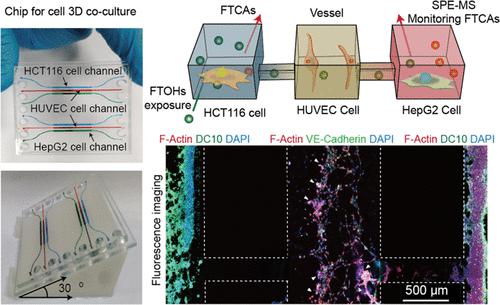当前位置:
X-MOL 学术
›
Anal. Chem.
›
论文详情
Our official English website, www.x-mol.net, welcomes your
feedback! (Note: you will need to create a separate account there.)
Microfluidic Chip-Based Modeling of Three-Dimensional Intestine–Vessel–Liver Interactions in Fluorotelomer Alcohol Biotransformation
Analytical Chemistry ( IF 6.7 ) Pub Date : 2023-11-09 , DOI: 10.1021/acs.analchem.3c03892 Ning Xu 1 , Haifeng Lin 2 , Jin-Ming Lin 3 , Jie Cheng 1 , Peilong Wang 1 , Ling Lin 2
Analytical Chemistry ( IF 6.7 ) Pub Date : 2023-11-09 , DOI: 10.1021/acs.analchem.3c03892 Ning Xu 1 , Haifeng Lin 2 , Jin-Ming Lin 3 , Jie Cheng 1 , Peilong Wang 1 , Ling Lin 2
Affiliation

|
Plyfluoroalkyl substance (PFAS), featured with incredible persistence and chronic toxicity, poses an emerging ecological and environmental crisis. Although significant progress has been made in PFAS metabolism in vivo, the underlying mechanism of metabolically active organ interactions in PFAS bioaccumulation remains largely unknown. We developed a microfluidic-based assay to recreate the intestine–vessel–liver interface in three dimensions, allowing for high-resolution, real-time images and precise quantification of intestine–vessel–liver interactions in PFAS biotransformation. In contrast to the scattered arrangement of vascular endothelium on the traditional d-polylysine-modified two-dimensional (2D) plate, the microtubules in our three-dimensional (3D) platform formed a dense honeycomb network through the ECM, with longer tubular structures. Additionally, the slope culture of epithelial cells in our platform exhibited a closely arranged and thicker cell layer than the planar culture. To dynamically monitor the metabolic crosstalk in the intestinal–vascular endothelium–liver interaction under exposure to fluorotelomer alcohols (FTOHs), we combined the chip with a solid-phase extraction-mass spectrometry (SPE-MS) system. Our findings revealed that endothelial cells were involved in the metabolic process of FTOHs. The transformation of intestinal epithelial and hepatic epithelial cells produces toxic metabolite fluorotelomer carboxylic acids (FTCAs), which circulate to endothelial cells and affect angiogenesis. This system shows promise as an enhanced surrogate model and platform for studying pollutant exposure as well as for biomedical and pharmaceutical research.
中文翻译:

基于微流控芯片的含氟调聚物酒精生物转化中三维肠-血管-肝脏相互作用的建模
多氟烷基物质(PFAS)具有令人难以置信的持久性和慢性毒性,造成了新的生态和环境危机。尽管 PFAS 体内代谢已取得重大进展,但 PFAS 生物累积中代谢活性器官相互作用的潜在机制仍然很大程度上未知。我们开发了一种基于微流体的检测方法,可以在三个维度上重建肠-血管-肝脏界面,从而获得高分辨率的实时图像,并精确量化 PFAS 生物转化中肠-血管-肝脏相互作用。与传统的d-聚赖氨酸修饰的二维(2D)板上血管内皮的分散排列相反,我们的三维(3D)平台中的微管通过ECM形成致密的蜂窝状网络,具有更长的管状结构。此外,我们平台中的上皮细胞的斜坡培养物比平面培养物表现出排列紧密且更厚的细胞层。为了动态监测暴露于含氟调聚物醇(FTOH)下肠道-血管内皮-肝脏相互作用中的代谢串扰,我们将芯片与固相萃取质谱(SPE-MS)系统结合起来。我们的研究结果表明内皮细胞参与了 FTOH 的代谢过程。肠上皮和肝上皮细胞的转化产生有毒代谢物氟调聚物羧酸(FTCA),其循环至内皮细胞并影响血管生成。该系统有望成为研究污染物暴露以及生物医学和药物研究的增强替代模型和平台。
更新日期:2023-11-09
中文翻译:

基于微流控芯片的含氟调聚物酒精生物转化中三维肠-血管-肝脏相互作用的建模
多氟烷基物质(PFAS)具有令人难以置信的持久性和慢性毒性,造成了新的生态和环境危机。尽管 PFAS 体内代谢已取得重大进展,但 PFAS 生物累积中代谢活性器官相互作用的潜在机制仍然很大程度上未知。我们开发了一种基于微流体的检测方法,可以在三个维度上重建肠-血管-肝脏界面,从而获得高分辨率的实时图像,并精确量化 PFAS 生物转化中肠-血管-肝脏相互作用。与传统的d-聚赖氨酸修饰的二维(2D)板上血管内皮的分散排列相反,我们的三维(3D)平台中的微管通过ECM形成致密的蜂窝状网络,具有更长的管状结构。此外,我们平台中的上皮细胞的斜坡培养物比平面培养物表现出排列紧密且更厚的细胞层。为了动态监测暴露于含氟调聚物醇(FTOH)下肠道-血管内皮-肝脏相互作用中的代谢串扰,我们将芯片与固相萃取质谱(SPE-MS)系统结合起来。我们的研究结果表明内皮细胞参与了 FTOH 的代谢过程。肠上皮和肝上皮细胞的转化产生有毒代谢物氟调聚物羧酸(FTCA),其循环至内皮细胞并影响血管生成。该系统有望成为研究污染物暴露以及生物医学和药物研究的增强替代模型和平台。





















































 京公网安备 11010802027423号
京公网安备 11010802027423号